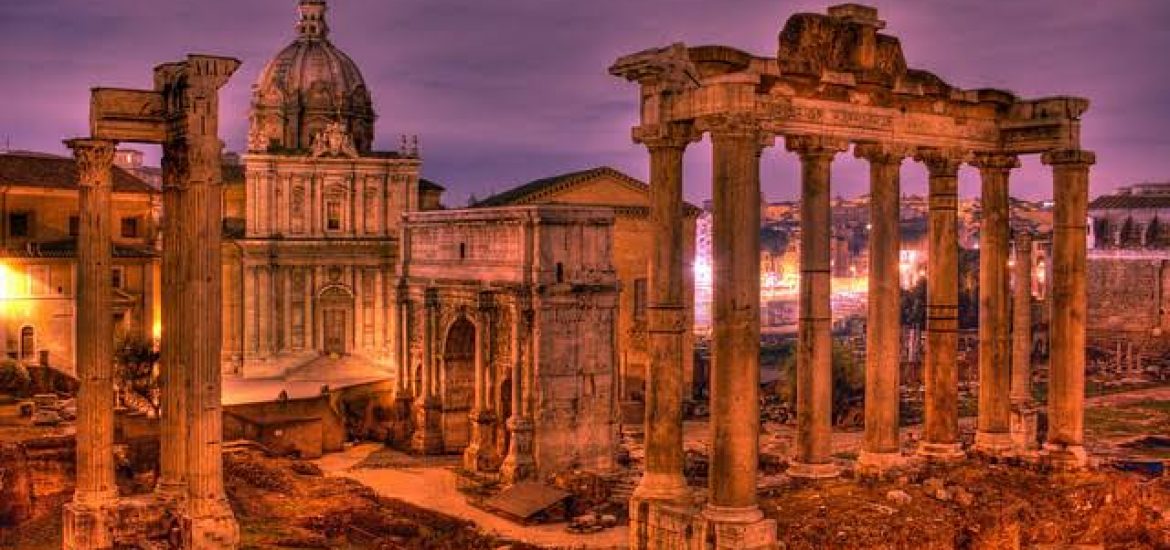
“We should try to imagine the Roman world, through and through, as an ecological context for microorganisms.”
Kyle Harper, The Fate of Rome, p. 17
For two centuries, Edward Gibbon’s The History of the Decline and Fall of the Roman Empire provided the definitive case for why the Roman Empire collapsed. According to Gibbon, human decadence – moral decline, corruption, and internal political division – left Rome susceptible to barbarian invasion and economic disintegration. This thesis squared with Europe’s Enlightenment-era philosophy built on reason and individual accountability. The Romans were special, in other words, but lost their edge over time.
 Yet nonhuman forces of climate and disease, according to Kyle Harper’s The Fate of Rome: Climate, Disease, and the End of an Empire (Princeton University Press, 2017), played a cardinal role in Rome’s rise and fall across three climate periods: the Roman Climate Optimum (RCO), 200 BC-AD 150; the Roman Transitional Period, AD 150-450; and the Late Antique Little Ice Age, AD 450-700.
Yet nonhuman forces of climate and disease, according to Kyle Harper’s The Fate of Rome: Climate, Disease, and the End of an Empire (Princeton University Press, 2017), played a cardinal role in Rome’s rise and fall across three climate periods: the Roman Climate Optimum (RCO), 200 BC-AD 150; the Roman Transitional Period, AD 150-450; and the Late Antique Little Ice Age, AD 450-700.
The Romans, Harper argues, were environmentally fortunate and then decidedly less so. Favorable climate conditions – warmer temperatures, abundant rainfall and few volcanic eruptions – bred an “efflorescence” of wealth, population, and food during the RCO. Gibbon himself called the mid-second century AD the “happiest age.” The arrival of “perhaps the first pandemic in human history” (p. 24), the Antonine Plague in 166 AD, however, ended the party and initiated a series of challenges. The advent of colder temperatures aided by volcanic eruptions and the bubonic plague in AD 540 eviscerated the Eastern Roman emperor Justinian’s best laid plans to revive the empire, which included retaking Rome itself, which had fallen to Goths in AD 410.
The Fate of Rome traces the long arc of Rome’s rise and fall through new scientific methods alongside the first-hand accounts of ancient writers. The result is an engaging story that carries obvious relevance for understanding “the awesome, uncanny power of nature” (p. 22) in determining the fate of civilizations, but also the fierce resilience of humanity to weather climate and disease shocks.
From efflorescence to sickness
The 350-year period of climate goodness helped Rome endure and flourish during the RCO, despite decades of foreign and civil wars in the first century BC. Warm temperatures allowed famers to plant olive trees, for instance, further north and at higher altitudes than ever before. In the southern Mediterranean, greater precipitation nurtured an agricultural renaissance. The lack of volcanic eruptions also stabilized the climate. In the ancient world, population was king, and Rome’s grew to its height during the 150 years after Augustus died in AD 14, thanks to ample food supply. Harper connects Rome’s experience to that of Han China. “[Their] simultaneous efflorescence…is one of history’s many ‘strange parallels,’ synchronous pulses of growth and retraction on a global scale” (p. 40).
The first hit came with the Antonine Plague, killing 10-20 percent of the empire’s population (p. 115), which initiated the Roman Transitional Period, AD 150-450. It was a harbinger of things to come, but Rome bounced back. Emperor Septimus Severus (AD 193-211) paid such attention to food supply that he fortified the grain dole for the city of Rome for seven years after his death (p. 57). The third century brought new climatic challenges, namely sharper solar variability (p. 131). The Plague of Cyprian, a viral hemorrhagic fever, also entered the empire from AD 251. Rome faced its most existential threat yet, as Goths and Persians invaded, while political leadership disintegrated. But, yet again, Rome proved resilient and, “the climate stabilized. After AD 266, there was not a major volcanic event for more than a century and a half. Solar output escalated, reaching its maximum […] around AD 300 and then maintaining high levels through the fifth century” (p. 168).
The last two chapters are the most gripping. The world’s first bubonic plague, brought by rats from southeast Asia, decimated the population, while the climatic pangs of the Late Antique Little Ice Age, AD 450-700, reduced the empire to a rump state. By the fifth century, Rome was Constantinople, except for a three-decade period after which Justinian’s general Belisarius reconquered and held Rome, AD 536-565. The plague, however, began arriving in Constantinople in AD 541. Meanwhile, “the AD 530s and 540s were not just frosty. They were the coldest decades in the late Holocene. The reign of Justinian was beset by an epic, once-in-a-few-millennia cold snap, global in scale.” (p. 219).

Source: Fate of Rome, p. 255.
In 536, a massive volcanic eruption produced the coldest year of the last two millennia. Summer temperatures fell 2.5°C in Europe (p. 253). Another volcano erupted in AD 539-40. These covered the skies in darkness, but their effects were short-lived. The real problem was weak solar energy from the AD 530s to 680s. “A grand solar minimum, centered in the late seventh century, was the greatest plunge in energy received from the sun during the last 2,000 years” (p. 254-5). The eastern provinces no longer produced agricultural as before, and their populations shrunk. Islamic armies overran them in the AD 630s and 640s, which Harper interestingly marks as the end of Rome’s empire: “With the detachment of the eastern possessions, the empire’s last great zone of energy was lost” (p. 286).
The climate-disease nexus
The irony of Rome’s later environmental and epidemiological troubles is that they grew out of its veritable success. By linking lands from Britain to Egypt and Syria to Spain in commerce and people, disease flourished.
“The Roman Empire was built in a Malthusian world of energy constraints, but it was able to shove back those limits through a heady combination of trade and technical advance. The power of the empire was both a premise and an outcome of demographic expansion and economic growth…The rousing forces of climate change and infectious disease constantly acted upon this complex system, in a series of two-way relationships. Even in the case of the physical environment, where forces entirely beyond human control operated, the effects of climate change depended on the specific arrangements between an agrarian economy and the machinery of empire. And the history of infectious disease is always thoroughly dependent on ecologies constructed by human civilization” (p. 20).
When thinking about our energy world, we tend to silo climate and disease. But it is plain that we have been experiencing a similar climate-disease nexus in recent decades. Carbon emissions are like gradual, consistent volcanic eruptions, slowly and imperceptibly killing crop yields and people. New pandemics – HIV, Ebola, and Zika, among others – have sprouted in the context of globalizing trade and human movement. People living in the Late Antique Little Ice Age, in contrast, were immediately aware of the dirty air and colder temperatures. Harper’s narrative should, therefore, give even the most sanguine futurist pause and drive home the fact that climate change makes us more susceptible to pandemic than we like to believe.
Energy and staying power
Harper’s narrative contains insights into energy and geopolitics as well. Human labor, freemen and slaves alike, were the primary energy inputs of the Roman world, but this required ample grain. Augustus’ annexation of Egypt in 30 BC provided grain-supply security and powered the Roman military and economy. The Arab conquest of Egypt erased it. Harper’s earlier work, Slavery in the Late Roman World, AD 275-425, likely features these themes more prominently.
The Fate of Rome is engaging and accessible for readers of all stripes. Historians will appreciate the fuller picture gained from incorporating nonhuman forces into our understanding of the past, as William McNeill did in the 1970s with his Plagues and Peoples. Its story will also resonate with those interested in climate change, empire, and science.
Unlike the Romans, we have the benefit of understanding climate change and its macro effects. We also have the technologies to tackle it and forecast its future contours. This summer, NASA predicted that the next solar cycle, from 2020 to 2025, would be the weakest of the last 200 years. The Romans, on the other hand, had no such capacities and faced clear Malthusian limitations. “The more general implication [of this study] is that preindustrial economies were springy, and the ‘vibrations’ of Malthusian theory could work themselves out over very long stretches of time. Modernity has been built on a singular energy breakthrough, but there were premonitions, and Rome was one” (p. 290). Roman resilience was remarkable, but they lacked the technology to adapt. Resilience and adaptation are the only ways that we can avoid a similar fate as Rome as we barrel ahead towards an uncertain future.
Photo credit: flickr.






[…] To Read More, Please Visit Source […]
Very Informative post. It describe the current senerio very briefly.